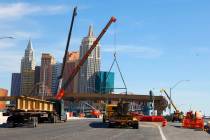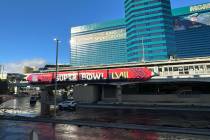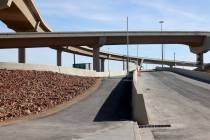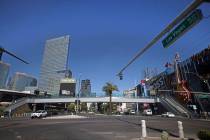How long to cross the road?
This week readers want to know why some crosswalk signals count down 22 seconds when flashing "don’t walk," what is the construction for on Washington Avenue east of Nellis Boulevard, and is it legal to drive a car in Nevada with only a rear license plate showing?
Al Wirtzbaum asks: Can you please let us know why the countdown on pedestrian traffic signals going from a walk signal to a don’t walk signal is 22 seconds?
Firstly, I learned that 22 seconds is not an all encompassing number.
It really depends on the intersection and how far it is across the street that determines the time on the walk signal, said Tracy Bower, spokeswoman for the Regional Transportation Commission.
"The length of time for the walk signal and flashing don’t walk signal are directly proportional to the width of the street," Bower said.
The Manual on Uniform Traffic Control Devices, written by federal transportation officials, is used as a guideline. The manual assumes a pedestrian walks 4 feet per second, or 3 mph.
So crossing 80 feet to get to the other side of the street would require a minimum of 20 seconds of crossing time, which includes both the walk and flashing don’t walk signals, Bower said.
"The duration of the walk signal is also based on how many pedestrians are likely to be present and waiting to cross the street," Bower said.
Most intersections spend seven seconds flashing the walk signal, but on the Strip it could be as long as 20 seconds because of the number of people crossing, Bower said.
A different example involves an extended green signal for vehicles on a main thoroughfare such as Flamingo Road.
In that case, someone walking east or west parallel to Flamingo might run into crosswalk signals that are extended to coincide with longer running green lights.
In such cases a walk signal may last longer than 60 seconds, Bower said.
Paulette Juryn asks: For the past few weeks there has been some kind of road work on Washington east of Nellis Boulevard near Linn Lane. Is there any way to find out what is being done? I haven’t seen any vehicles marked with any utility association.
The project is part of a Clark County project to install school flashers near Eldorado High School, said public works spokesman Bobby Shelton.
Wheeler Electric is the on-site contractor, he added.
The project began June 1 and is estimated to be finished by Oct. 1.
"Currently, the project is one-third complete with underground conduits installed, with flasher arms to be installed in the near future," Shelton said.
Donald Ross: I purchased a car that came from Arizona. It had no front plate and no bracket or mounting holes for a plate. Is it legal in Nevada to drive with only the back plate on?
It’s perfectly legal.
According to Nevada Revised Statute 482.275, section 2 states that if the vehicle was not manufactured to include a bracket to secure a front license plate and none is provided otherwise, a license plate must be attached to the motor vehicle in the rear. It’s optional for the vehicle owner to install the front license plate. However, the law reads that if there is a bracket for a front plate, it must be put on.
The law changed in 2005. The Nevada Legislature did so because some car manufacturers were building vehicles without a place for the front plate.
If you have a question, tip or tirade, call Francis McCabe at (702) 387-2904, or send an e-mail to roadwarrior@reviewjournal.com. Please include your phone number.
Motorists should watch for intermittent closures of Summerlin Parkway in the coming days because of the ongoing construction of the $7.9 million Tenaya Way overpass. Motorists should watch for posted detour signs.•Beginning at 11 p.m. today through 5 a.m. Thursday, eastbound Summerlin Parkway at Buffalo Drive will be closed. Suggested detour: Exit at Buffalo, head south on Buffalo, east on Westcliff Drive, and then north on Rainbow Boulevard to U.S. Highway 95 interchange.
The Nevada Department of Transportation announced the following updates to the ongoing $240 million Interstate 15 north widening project:
•Bonanza Road at Interstate 15 will be closed from 9 p.m. today to 6 p.m. Thursday.
•The Lake Mead Boulevard interchange with I-15 and Lake Mead Boulevard, from Las Vegas Boulevard to Losee Road, will be closed from 9 p.m. Friday to 5 a.m. Monday, for bridge demolition. Motorists should detour via the Cheyenne Avenue interchange.
•Lake Mead will be closed in each direction from 9 p.m. to 5 a.m. Monday through Thursday through July 31.
•The Lake Mead onramp to I-15 southbound will be closed from 9 p.m. July 22 to 5 a.m. July 27.
•The Lake Mead onramp to I-15 northbound will be closed beginning July 24 for two months. Motorists should use the Washington Avenue onramp.
•The I-15 southbound exit to Lake Mead is closed through September.
•The Cheyenne onramp to I-15 southbound will be closed from 9 p.m. July 21 to 5 a.m. July 22 for ramp work.
•Major lane shifts will be in effect from 9 p.m. to 5 a.m. daily beginning July 19 through July 22 from Washington Avenue to Craig Road. Motorists should watch for lane shifts.
LAS VEGAS REVIEW-JOURNAL


















